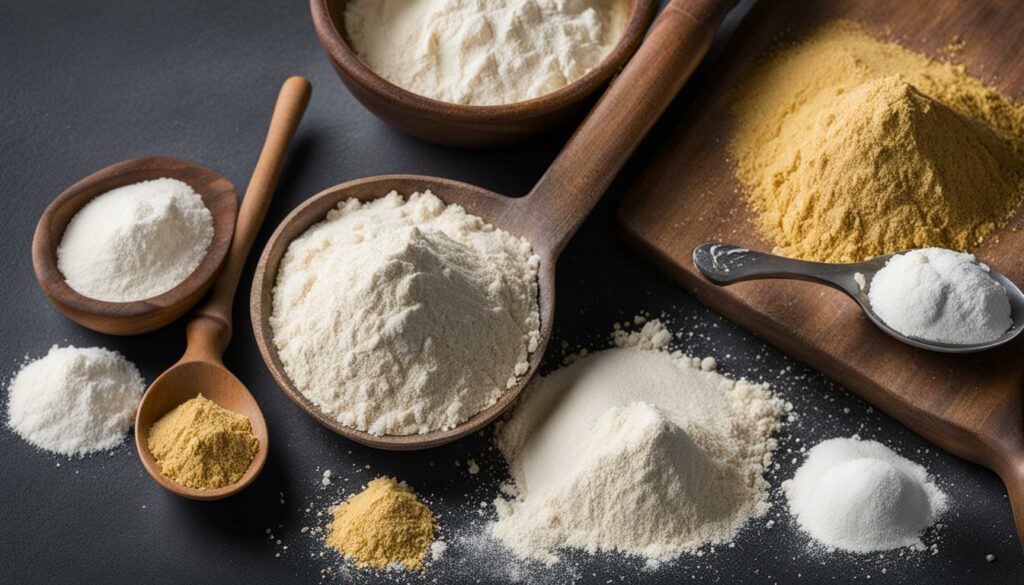Are you looking for a semolina flour substitute to enhance your baking experience or adapt to dietary restrictions? Look no further! In this comprehensive guide, we’ll explore various options for substituting semolina flour in your recipes. Whether you’re a seasoned baker or a beginner, this guide is for you.
Semolina flour, made from durum wheat, is a coarse flour commonly used in pasta and bread-making. Its distinctive texture and earthy flavor add a unique touch to many recipes. However, it may not always be readily available or suitable for everyone’s needs.
Don’t let that stop you from creating delicious recipes! With our guide, you’ll discover alternative options for semolina flour and learn how to use them in your favorite dishes.
Key Takeaways:
- Substituting semolina flour can elevate your baking experience and open up new possibilities in the kitchen.
- Alternative options to semolina flour include all-purpose flour, bread flour, whole wheat flour, durum flour, cornmeal, rice flour, tapioca flour, and gluten-free flour.
- Experimenting with different substitutes will allow you to create delicious recipes without compromising on taste or texture.
- Consider using all-purpose flour for readily available substitute or bread flour for doughs.
- Whole wheat flour is a nutritious alternative, while durum flour, cornmeal, rice flour, and tapioca flour offer specialized substitutes.

Understanding Semolina Flour
Before we dive into finding the best semolina flour substitute, it’s important to first understand what semolina flour is. Semolina flour is a coarse flour that is made from durum wheat, which is a hard wheat variety that is high in protein and gluten. It is commonly used in pasta and bread-making due to its unique texture and earthy flavor.
When durum wheat is milled, the endosperm, which is the starchy part of the wheat grain, is ground into semolina flour. The bran and germ, which contain most of the nutrients in the wheat, are removed during the milling process, resulting in a flour that is lower in fiber and nutrients compared to whole wheat flour.
Due to its high gluten content, semolina flour is ideal for making doughs that require elasticity and structure, such as pasta dough, pizza dough, and bread dough. It also adds a distinct texture and flavor to baked goods, making it a popular ingredient in many recipes.
All-Purpose Flour: The Versatile Substitute
If you’re in a pinch and need a readily available semolina flour substitute, all-purpose flour is your best bet. It’s a staple in most kitchens and can be used in a variety of recipes, both for baking and cooking.
All-purpose flour is commonly used in place of semolina flour in bread, pastries, and desserts, as it produces similar results. However, keep in mind that it may not replicate the exact texture and flavor of semolina flour.
| Semolina Flour | All-Purpose Flour |
|---|---|
| Coarse texture | Fine texture |
| Earthy flavor | Neutral flavor |
| Used in pasta and bread-making | Used in various recipes |
When using all-purpose flour as a semolina flour substitute, keep in mind that it may require more or less liquid, depending on the recipe. It’s also important to note that all-purpose flour doesn’t contain as much protein as semolina flour, which may affect the texture of certain recipes.
Overall, all-purpose flour is a reliable and versatile substitute for semolina flour in most recipes, making it a great option for those who want to experiment in the kitchen.

Bread Flour: The Perfect Substitute for Doughs
If you’re looking for a semolina flour substitute to make your favorite bread or pizza dough, bread flour is an excellent option. With its high protein content, bread flour provides the necessary structure and chewiness that is essential for these types of dough.
When using bread flour as a substitute, keep in mind that it absorbs more liquid than semolina flour, so you may need to adjust your recipe accordingly. Start by replacing the semolina flour with an equal amount of bread flour and gradually add more liquid until the dough reaches the desired consistency.
Not only does bread flour work well in doughs, but it can also be used in other recipes that call for semolina flour, such as certain types of pasta. Experiment with different ratios to find the perfect balance for your recipe.
Bread Flour vs. Semolina Flour: A Comparison
| Flour | Protein Content | Texture | Flavor |
|---|---|---|---|
| Bread Flour | 12-14% | Chewy | Mild |
| Semolina Flour | 12-13% | Coarse | Earthy |
As you can see from the table, bread flour and semolina flour have similar protein content, but differ in texture and flavor. While bread flour provides chewiness, semolina flour adds a coarse texture and earthy flavor to recipes. Take this into consideration when deciding which flour to use as a substitute.
Tip: If you don’t have bread flour on hand, you can make your own by combining all-purpose flour with vital wheat gluten. Simply add 1 tablespoon of vital wheat gluten to every cup of all-purpose flour.
Whole Wheat Flour: A Nutritious Alternative
If you’re looking for a healthier twist on your recipes, whole wheat flour is an excellent semolina flour substitute. In addition to its nutritional benefits, such as higher fiber content, whole wheat flour adds a nutty flavor and slightly denser texture.
When substituting whole wheat flour for semolina in baking, it’s important to keep in mind that the texture and flavor will not be exactly the same. However, it can be used in recipes such as bread, muffins, and certain pasta dishes.
| Benefits of Whole Wheat Flour | |
|---|---|
| Higher Fiber Content | Whole wheat flour has a higher fiber content than semolina, making it a healthier choice. |
| Nutty Flavor | Whole wheat flour adds a nutty flavor to your recipes, which can enhance the overall taste. |
| Denser Texture | Whole wheat flour has a denser texture compared to semolina, which can make your baked goods more filling. |
When using whole wheat flour as a semolina flour substitute, keep in mind that it may require more liquid in the recipe due to its absorbent nature. Additionally, it’s important to note that whole wheat flour has a shorter shelf life compared to semolina, so be sure to use it within a reasonable amount of time.
If you want to experiment with using whole wheat flour in your recipes, try substituting a portion of the semolina flour with whole wheat flour to see how it affects the texture and flavor. Over time, you may find that you prefer the taste and health benefits of using whole wheat flour in your baking.

Exploring Other Substitutes
If you’re looking to add a unique twist to your recipes, consider using some of these alternative substitutes for semolina flour.
Durum Flour
Durum flour is another type of wheat flour, made from the same durum wheat as semolina. It has a similar texture and taste, making it a great substitute in recipes that call for semolina flour. Durum flour is commonly used in making pasta, bread, and pizza dough.
Cornmeal
Cornmeal is a coarsely ground flour made from corn. It has a slightly gritty texture that can add a nice crunch to your recipes. It works well in cornbread, muffins, and certain desserts. Cornmeal is a good substitute for semolina in recipes that require a similar texture.
Rice Flour
Rice flour is a gluten-free alternative to semolina flour, making it suitable for those with gluten sensitivities or allergies. It has a light texture and a slightly sweet taste that adds a unique flavor to your recipes. Rice flour is commonly used in making noodles, dumplings, and certain desserts.
Tapioca Flour
Tapioca flour is another gluten-free option that can be used as a substitute for semolina flour. It has a starchy texture and a slightly sweet taste that works well in certain types of bread and pastries. Tapioca flour is made from the cassava root, and is often used in gluten-free recipes as a thickening agent or to add moisture to baked goods.
Gluten-Free Flour Mix
If you’re looking for a pre-made, all-purpose gluten-free flour mix, there are many options available on the market. These blends typically contain a mix of rice flour, tapioca flour, potato starch, and other gluten-free flours. They can be used as a substitute for semolina flour in most recipes, and are a convenient option for those with gluten sensitivities or allergies.
Experimenting with different substitutes can add new flavors and textures to your recipes, and may even inspire you to create your own unique dishes. Whether you opt for durum flour, cornmeal, rice flour, tapioca flour, or a gluten-free flour mix, these substitutes allow you to create delicious recipes without compromising on taste or texture.
Conclusion
Congratulations on making it to the end of our helpful guide on finding the best semolina flour substitutes for your recipes! We hope that you found this comprehensive guide useful and informative.
By now, you should have a good understanding of what semolina flour is and the various substitutes you can use in its place. Remember, all-purpose flour is a versatile substitute that works well in most recipes, while bread flour is perfect for making doughs. Whole wheat flour is a nutritious alternative, and if you have specific dietary restrictions, consider using durum flour, cornmeal, rice flour, or tapioca flour.
Experimenting with different substitutes can open up new possibilities in the kitchen and elevate your baking experience. So why not try using one of these alternatives in your next recipe? You never know, you might just discover a new favorite ingredient that you can’t live without.
We hope that these tips and recommendations have given you the confidence to explore the wonderful world of baking without compromising on taste or texture. Happy baking!